Curing Classical Homocysteinuria with Pediatric in vitro engineered Liver Organoid Transplantation?
IF 1.6
4区 医学
Q4 NEUROSCIENCES
引用次数: 0
Abstract
Organoids are groups of cells grown in the laboratory that have self- organized into cell structures resembling those of organs. The term "organoid" means "organ-like." In many cases, the cells and cell structures give organoids abilities similar to those of the organs they resemble. Brain organoids, for example, develop layers of nerve cells (neurons) with signaling activity and even "brain regions" that resemble areas of the human brain. Currently, organoids created by researchers may bear a strong resemblance to a fully mature organ in certain respects, but crucial differences still exist. Intestinal organoids have a variety of cellular structures that resemble parts of the intestinal mucosa, but are typically the size of a pea and thus not nearly as large or complex as our intestinal tract. But even though they are small, or do not correspond one hundred percent to entire organs, scientists can learn a lot from organoids. Experts believe that organoids represent the "next generation" of biological tools for research, drug development and medicine. Liver Organoid engineering could play an important role in treating and curing classic homocysteinuria in childhood by resetting the disturbed function of cystathion beta synthetase activity in the implanted organoid liver. This manuscript focus on liver organoid research to date with special attention to classic homocysteinuria in childhood.小儿体外工程肝类器官移植治疗经典同型半胱氨酸尿?
类器官是在实验室中培养的细胞群,它们具有自组织成类似器官的细胞结构。“类器官”一词的意思是“类似器官”。在许多情况下,细胞和细胞结构赋予类器官与它们相似的器官相似的能力。例如,大脑类器官发育出具有信号活动的神经细胞层(神经元),甚至是类似人类大脑区域的“大脑区域”。目前,研究人员创造的类器官在某些方面可能与完全成熟的器官非常相似,但仍存在关键差异。肠道类器官具有多种细胞结构,类似于肠粘膜的某些部分,但通常只有豌豆大小,因此不像我们的肠道那么大或复杂。但是,即使它们很小,或者不能百分之百地与整个器官相对应,科学家也可以从类器官中学到很多东西。专家认为,类器官代表了用于研究、药物开发和医学的“下一代”生物工具。肝脏类器官工程可以通过修复移植类器官肝脏胱胱甘肽合成酶活性紊乱的功能,在治疗儿童经典同型半胱氨酸尿中发挥重要作用。本手稿集中于肝类器官的研究,特别关注儿童经典同型半胱氨酸尿。
本文章由计算机程序翻译,如有差异,请以英文原文为准。
求助全文
约1分钟内获得全文
求助全文
来源期刊
CiteScore
5.40
自引率
3.60%
发文量
22
审稿时长
>12 weeks
期刊介绍:
This interdisciplinary journal publishes papers relating to the plasticity and response of the nervous system to accidental or experimental injuries and their interventions, transplantation, neurodegenerative disorders and experimental strategies to improve regeneration or functional recovery and rehabilitation. Experimental and clinical research papers adopting fresh conceptual approaches are encouraged. The overriding criteria for publication are novelty, significant experimental or clinical relevance and interest to a multidisciplinary audience. Experiments on un-anesthetized animals should conform with the standards for the use of laboratory animals as established by the Institute of Laboratory Animal Resources, US National Academy of Sciences. Experiments in which paralytic agents are used must be justified. Patient identity should be concealed. All manuscripts are sent out for blind peer review to editorial board members or outside reviewers. Restorative Neurology and Neuroscience is a member of Neuroscience Peer Review Consortium.

 求助内容:
求助内容: 应助结果提醒方式:
应助结果提醒方式:


